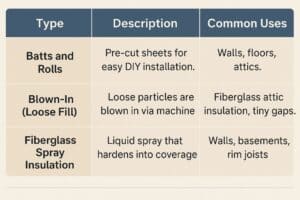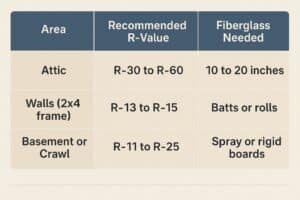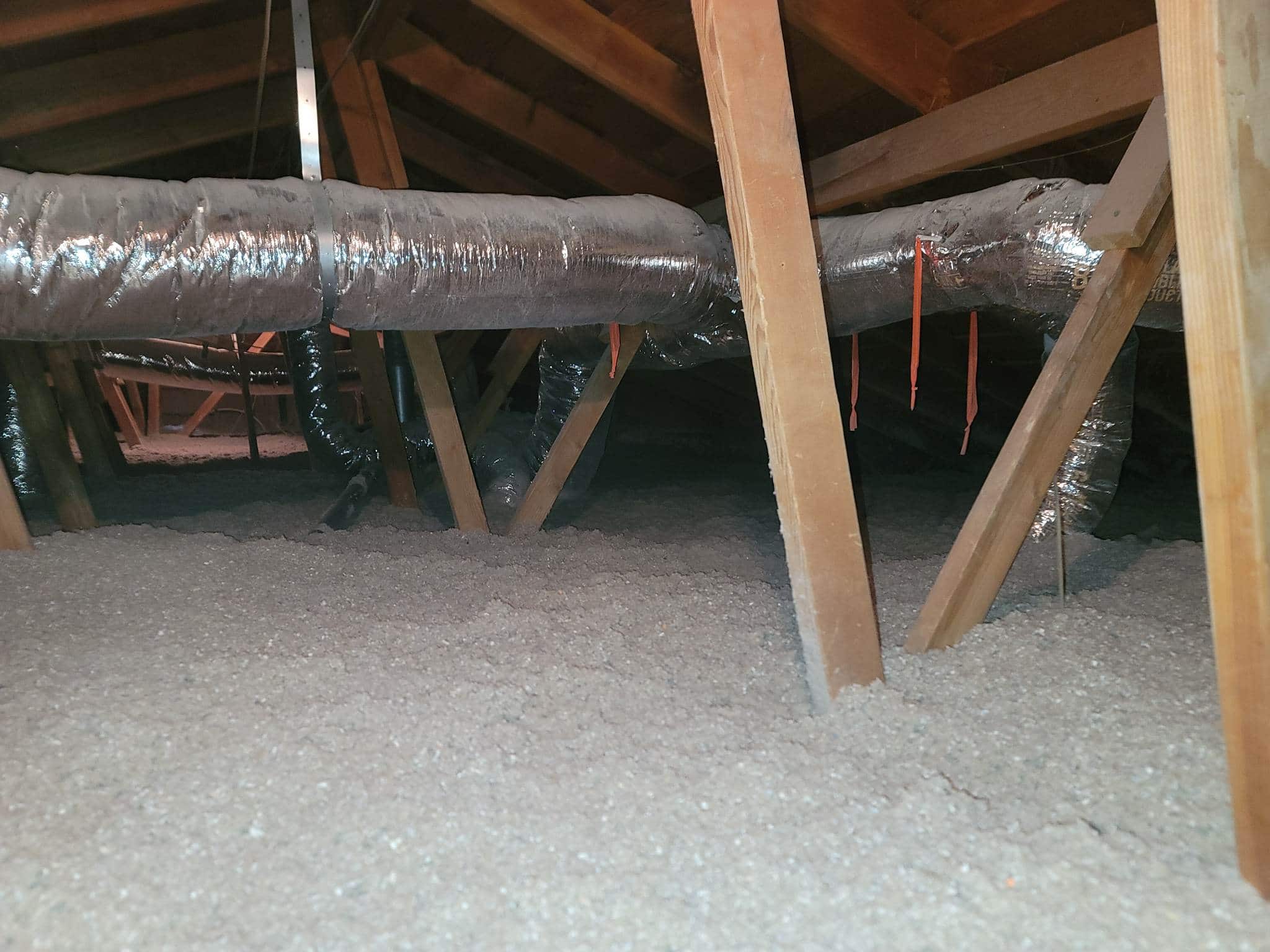Are you searching for a clear strategy to keep your home cozy while being energy efficient? Insulation fiberglass can be the answer. Construction-wise, fiberglass is very common and inexpensive.
Did you know? The U.S. Department of Energy states that homes that are well insulated can save as much as 15% on heating and cooling costs annually. In fact, getting that insulation fiberglass is among the most popular and economical ways to do it.
In this blog, we will examine the components of fiberglass insulation, how it operates, and the reasons why millions of homeowners and contractors continue to trust it. Stay tuned to get more insightful information.
What Makes Fiberglass Insulation So Effective?
Fiberglass insulation consists of very thin strands of glass spun into a wool-like texture. The strands trap air, reducing the transfer of heat.
Unlike cooling materials, fiberglass delays the passage of heat through conduction (direct contact), convection (movement of air), and even radiation (infrared heat). That’s why it’s so effective year-round.
What is the process of making fiberglass insulation?
It is a mix of technology and eco-friendly methods. The manufacturers melt sand and recycled glass at extreme temperatures and later spin them to form threads.
These threads are;
- Shaped into rolls known as batts
- Blown loosely into places
- Fiberglass spray insulation, which is sprayed on in a foam-like form.
Some are vapor faced with paper or foil barrier, while others are left unfaced for flexible use.
Various Kinds of Fiberglass Insulation and Their Applications
Let’s take a quick review of the principal groups of fiberglass insulation and their applications:

How to Select the Right Fiberglass Insulation for Your House
- Employ batts in generous wall spaces.
- Choose blown-in for narrow or irregularly shaped areas.
- Select spray for soundproofing and tight seals.
Often, several serve a combination purpose for the best coverage.
What is the Importance of Fiberglass Attic Insulation?
Importance of attics in energy efficiency
Warm air rises; if your attic is not insulated well, heat escapes during winter and comes in during summer.
Fiberglass attic insulation has advantages. It provides an insulation barrier that seals the heated air indoors.
Actual Cost Savings of Fiberglass Attic Insulation:
- Decreases heating or cooling costs.
- Maintains temperature consistency indoors.
- Reduces moisture buildup inside.
- Increases the lifespan of HVAC systems.
Benefits of Fiberglass Insulation
Let us consider the overview first.
Important Insights – Why Fiberglass is Still the Best
- Budget-Friendly: One of the lowest costs per square foot.
- Environmentally Friendly: Manufactured with recycled materials.
- Does Not Burn: Safe around electricals and pipes.
- Mold & Moisture Resistant: Safer home and healthier living.
- Sound Reduction: Offers a degree of soundproofing between areas.
Where is fiberglass spray insulation most useful?
Like many other innovations in the insulation space, fiberglass spray insulation is now widespread because of its uniform application and comprehensive coverage.
Use spray insulation in:
- Crawl Spaces
- Garage Ceilings
- Knee Wall Areas
- Rim Joists
- Walls of the Basement
The unique property of spray insulation, which expands upon application, makes it far superior to batts and rolls when it comes to reducing air leaks.
Understanding R-Value in Fiberglass Insulation
What’s R-value, and why do we need it?
R-value indicates the thermal resistance of a particular material. It is easy to understand that the value of R is high, and the insulation is better.
This is a general rule for fiberglass:

While we provide some guidelines, please remember to check local building regulations as they often differ.
When You Should Consider Fiberglass Insulation Removal
The removal of fiberglass insulation becomes necessary in several particular situations.
When to Remove Your Old Insulation
- If it is aged beyond 20 years.
- If you see or smell any hint of mold.
- After a rodent or pest infestation.
- After any flood-related damage.
- While undergoing extensive renovations.
Broken insulation can negatively impact your home’s energy efficiency and pose a health risk. Removing it ensures that your new insulation will function optimally.
Installing Fiberglass Insulation: DIY or Hire a Pro?
Batts and rolls? Yes, you can do it yourself. But, for blown-in and spray, better call the pros.
Benefits of hiring a contractor:
- They make certain the proper R-value is followed for each region.
- They know how to seal gaps completely.
- They bring the right tools for spray insulation.
While professional installation may incur higher upfront costs, it pays off in the long run.
How Long Does It Last and What Maintenance Is Needed?
Fiberglass is exceptionally durable and lasts 50 to 100 years.
For maintenance, experts recommend:
- Performing inspections every 15–20 years.
- Replace or upgrade it after visible deterioration.
Besides, animals or bulky items kept in the attic may compress batts, thus reducing their R-value.
Busting the Myths Surrounding Insulation
Common Myths About Fiberglass Insulation
- Myth: It’s unsafe to touch.
- Fact: New fiberglass is safer; however, it’s best to use gloves and a mask while handling it.
- Myth: Additional insulation will always yield better outcomes.
- Fact: There is a point of diminishing returns. Stick to the code.
- Myth: Insulation has a uniform structure.
- Fact: Insulation fiberglass is different from foam, cellulose, and wool.
Easy Hacks To Improve Insulation Effectiveness
- Add insulation only after air sealing has been addressed.
- Ensure that the insulation type matches the purpose of the room.
- If water or pests have previously damaged the area, consider upgrading to the best fiberglass insulation.
- Think about hiring specialists for fiberglass insulation removal if the installation is over 20 years old.
Start Saving Energy Now
Your fiberglass insulation makes your home energy-efficient, soundproof, and protective, so it feels cozy every single day, not just in spring or fall. Considering a change? The professionals at My Insulation Guy will provide you with proper guidance, dependable service, and long-lasting results. Take advantage of our complimentary energy assessment today so you can enjoy reduced bills by tomorrow.
FAQs
- What is the cost of fiberglass insulation per square foot?
It usually falls between $0.40 and $1.50 per square foot based on thickness and R-value.
- Is fiberglass batt insulation more efficient than fiberglass spray insulation?
Spray insulation is more expensive but provides better coverage and seals leaks more effectively.
- Can fiberglass insulation combust?
No. It doesn’t catch fire and has a high melting point meaning it’s safe around electrical parts.
- What does old fiberglass insulation removal entail?
Using vacuums and protective clothing, professionals extract old, contaminated, or damaged insulation.
- Is fiberglass safe for the quality of air indoors?
Yes, modern fiberglass VOCs are lower and free of formaldehyde which makes it safer.

